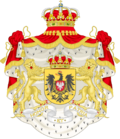Nikolia
This article is incomplete because it is pending further input from participants, or it is a work-in-progress by one author. Please comment on this article's talk page to share your input, comments and questions. Note: To contribute to this article, you may need to seek help from the author(s) of this page. |
Kingdom of Nikolia Kraljevina Nikolija Królestwo Nikolskie | |
|---|---|
| Motto: "Čast i Otadžbina" (Serbian) "Honor i Ojczyzna" (Polish) "Honour and Fatherland" (English) | |
| Anthem: "Himna Kraljevine Nikolije" | |
| Capital | Carigrad |
| Largest city | Beograd |
| Official languages | Sirmian, Mazurian |
| Recognised regional languages | Sloverti, French, Tarnogorian, Lisatian |
| Demonym(s) | Nikolian |
| Government | Constitutional parliamentary federal monarchy |
• King | Aleksandar II of Nikolia |
| Branislav Jovanovski | |
| Legislature | Parliament of Nikolia |
| Council of Voivodeships | |
| National Assembly | |
| Formation | |
• Establishment of the Principality of Sirmia | 276 |
• Establishment of the Empire of Nikolia | 952 |
| 17 December 1677 | |
| Area | |
• Total | 3,059,600 km2 (1,181,300 sq mi) |
| Population | |
• 2020 census | 264,182,078 |
• Density | 86.3/km2 (223.5/sq mi) |
| GDP (PPP) | 2019 estimate |
• Total | $14.5 trillion |
• Per capita | $55,477 |
| GDP (nominal) | 2019 estimate |
• Total | $14.3 trillion |
• Per capita | $54,204 |
| Gini (2019) | medium |
| HDI (2019) | very high |
| Currency | Nikolian kruna (Kr) (NKK) |
| Time zone | (UTC) |
| Date format | dd.mm.yyyy |
| Driving side | right |
| Calling code | +645 |
| ISO 3166 code | NIK |
| Internet TLD | .nk |
Nikolia (Serbian: Nikolija ; Mazurian: Nikolia), officially the Kingdom of Nikolia (Serbian: Kraljevina Nikolija; Mazurian: Królestwo Nikolskie), is a country on the Mederano Peninsula on the continent of Teudallum in western Astyria. It shares its southern border with Berique, Slovertia, Khyragus and ViZion and a maritime border with Woodstead in northwest and Great Nortend in the northeast. Carigrad is the capital city of Nikolia, while the largest city is Beograd.
Nikolia is 11th largest country in Astyria and the largest on its continent with a total area of 3,059,6002 km. Its population of 264,182,078 (2020) is mostly distributed along the coastal areas with a substantial population in central parts of the country along the river valleys. Nikolia is divided in 24 federal units known as Voivodeships. The official languages of Nikolia are Sirmian and Mazurian, while recognised minority languages are Sloverti, French, Tarnogorian and Lisatian
The earliest Slavic state on the territory of modern Nikolia, the Principality of Sirmia was founded in 276 AD by Prince Stanislav I and is considered by scholars as the first Nikolian state. In 512 AD, King Uroš I unified several Slavic statelettes and expanded the territories further south. The early kingdom was challenged by the Ethlorekoz from the east and Berique from the south, nevertheless, the territory expanded further east. The largest expansion of the Nikolian territory happened in 952 AD when Stefan I founded the Empire of Nikolia and relocated the capital from Vladimirovac to Carigrad and brought Christianity to Nikolia in 964 AD.
Throughout the Middle Ages, the Nikolian Empire was more or less a complex of duchies, principalities and free cities with a decentralised elective monarch to which vassalised subjects had to provide allegiance. In 1415 Emperor Stanislav I started to unite subjects of the Empire and place them under his direct rule, which triggered War of the Crowns between the Imperial subjects, the Kingdom of Moravia and the Kingdom of Mazuria. After winning the war that lasted nearly 14 years, King Bolesław I of Mazuria was elected as new Emperor, during whose reign the Empire was renamed to Commonwealth of Nikolia-Mazuria and was vastly reformed: the territories of the Empire were consolidated into Voivodeships, a legislative body composing of nobility from the Voivodeships was founded and the Imperial powers were expanded.
In 17th century, Voivodeships started gaining more and more power, distancing themselves from the throne in Carigrad, with numbers of nobility rising. The people revolted against the inequality between the Imperial subjects which eventually led to unification of the Commonwealth into the Nikolian Empire in 1677. Voivodeships were restructured, their powers were reduced, while the Imperial throne had greater influence over the Voivodeships governing. Several of the Voivodeships, primarily Mazurian ones revolted, but their revolt was extinguished by both the Empire and lack of support of their people.
Throughout the 18th and 19th century, Nikolia faced socio-economic improvement and industrial growth. Democracy was also on the rise, which led to several important events, such as the new constitution in 1790 which abolished feudalism, restructured the government and gave more influence to the parliament. At the start of the 19th century, southwestern Nikolia was invaded by Berique under the leadership of Emperor Longin Bernadotte which later led to development of the Nikolian Armed Forces which were lacking in military equipment and skills.
In 1925, reign of Emperor Milan II, who adopted controversal fascist policies, ordered forced deportation of more than 200,000 Beriquois, Slovertians and Khyragusians from Nikolia and abolished the National Assembly in several occasions, was brought down by coup d'etat, led by his younger brother Petar IV. The December overturn, as the event is known in Nikolian history books, drastically reformed Nikolia: the Empire was replaced with Kingdom, the Monarch was stripped of most of its executive powers in turn creating the Government of Nikolia as principal executive body, the Parliament of Nikolia recieved broader legislative powers and the Constitution was amended.
Nowadays, Nikolia is a modern federal parliamentary monarchy and takes a high place in Astyria in economy, industry and culture. The Nikolian economy follows a social market socioeconomic model, with a mix of market economy and state interventionism ensuring fair competition and a strong welfare state.
History
Prehistory
Middle ages
Early modern era
Modern era
Great Astyrian War
Geography
Climate
Politics
Nikolia is a constitutional monarchy ruled by King Aleksandar II of Nikolia acting as a head of state. The power is distributed in 3 independent branches of the government: The executive branch is vested on the Crown Council of Nikolia and the Monarch, the legislation is vested on the unicameral parliament, the National Assembly of Nikolia and the Council of Voivodeships, which acts as an auxiliary legislative body composing of the representatives of the 24 Voivodeships of Nikolia, and the judiciary which is vested on the independent court system, among which the highest in hierarchy is the Supreme Court of Cassation.
Crown Council
The Crown Council (Serbian: Krunski savet, Mazurian: Rada Korony) is the supreme governmental council which brings together the principal officers of the executive branch of the Nikolian government. The Crown Council is composed of 14 government ministers, two representatives of the Constitutional Court of Nikolia and the Metropolitan of Carigrad. The Crown Council is presided over by the Chancellor of Nikolia, who serves as the de facto prime minister of Nikolia.
National Assembly
Council of Voivodeships
Administrative divisions
Nikolia is composed of twenty-four constituent states known as Voivodeships (Serbian: Vojvodstvo Mazurian: Województwo), which equals to a Duchy in other monarchies. Each Voivodeship has its own constitution, government, and is largely autonomous in regard to its internal organisation. Voivodeships are headed by a voivode who, together with the Voivodeship government represents the executive branch in the Voivodeship. Legislature is represented with parliaments of each Voivodeship. Voivodeships are further divided into counties (Serbian: Županija Mazurian: Powiat), which are in turn divided further into municipalities and cities.
| Voivodeship | Capital city | |
|---|---|---|
| in English | in Serbian or Mazurian | |
| Moravia | Moravija | Carigrad |
| Dumbrovia | Dumbrovija | Lepetani |
| Lower Dunaj | Podunajsko | Beograd |
| Mehedia | Meledija | Homolj na Dunaju |
| Kalabia | Kalabija | Ister |
| Mur | Mur | Korčula |
| Sirmia | Sirmija | Vladimirovac |
| Barania | Baranska | Zavojno |
| Vislovia | Vislovija | Ladovar |
| Venedia | Venedija | Nikolajevo |
| Kribian | Kribska | Zakribje |
| Kalesia | Kalesija | Komarovo |
| Nitria | Nitrija | Kavadarce |
| Ritenia | Ritenija | Zlatarje |
| Gledovia | Gledovija | Lipovac |
| Lisatia | Lizatija | Trebenj Gradec |
| Rascia | Raška | Rabrovac |
| Idria | Idrija | Krašovo |
| Wesolia | Wesołskie | Zapetane |
| Rumawia | Rumawskie | Czączek |
| Srebrogóra | Srebrogórskie | Złotów |
| Tarnogora | Tarnogorskie | Warta |
| Mazuria | Mazurskie | Katowice |
| Kuyavia | Kujawskie | Legnica |
Economics
Transport
Demographics
As of 2020, the total population of Nikolia is 264,182,078 inhabitants. The population density is 117 persons per square kilometer nationwide, with coastal areas more populated than central Nikolia. Nearly 68% of Nikolians live in urban areas. The largest city per population is Beograd, with 15,245,764 citizens, while nation's capital, Carigrad, has 5,191,690 inhabitants. Other larger cities are Katovice with 7,224,753 and Borča with 8,264,178 citizens.
Education
Nikolian educational system is well developed and is developed in 5 levels. Education is available to every Nikolian citizen and it's free up to fourth level (higher education) in which only students that perform under certain criteria set by universities and faculties in Nikolia must pay for tuition.
Language
Official languages in Nikolia are Serbian and Mazurian, with Serbian being predominately used by authorities considering the number of native speakers (610 million). Mazurian, although constitutional language, is mostly used in voivodeships of Mazuria and Leszka where there are majority of speakers of that language.
Serbian and Mazurian in schools
Serbian language is obligatory subject in all schools in Nikolia, and is primary language in voivodeships Moravia, Podunavia, Travunia, Nitria, Venedia, Rutenia, Dubrovia and Vlachia. Mazurian language is obligatory subject in schools in voivodeships of Mazuria and Leszka where is taught as primary language, while in remaining voivodeships is seen as secondary language.
Religion
Nikolians are predominantly christians with approximately 570 million Orthodox christians and approximately 150 million Roman catholics. The remaining percentage of people include atheists, protestants and pagans.
Culture
Education



